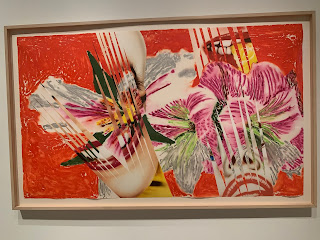I was fortunate enough to have visited on May 17th. I arrived prior to the museum opening and was among the first to enter. My transit through the exhibition was smooth.
The exhibition is distributed through 10 rooms of Gallery 74 on the museum's main floor while the painting Saint Martin in Glory with Saint Peter and St Paul is exhibited by itself in the hallway of Gallery B. Attendees are directed to this painting after completing the tour of the main exhibit.
 |
| Saint Martial in Glory with Saint Peter and Saint Paul Jacopo Tintoretto, 1549 |
The exhibition is organized chronologically for the most part and even though there are broader themes, they slotted in well with the overall chronological schema. The themes are shown in the table below.
Table 1. Organization of the exhibit.
Theme
|
Explanation
|
The Mark of the Brush
|
Tintoretto’s painting technique
|
Breakthrough
|
Miracle of the Slave (1548) was his breakthrough effort. This section features paintings dome just before, during, and just after that recognition
|
Drawings from Sculpture
|
Tintoretto drew sculptures as a way to understand 3-dimensional forms
|
Heroic Bodies
|
Muscular, dynamic figures inspired by his study of the works of Michelangelo and other sculptors from antiquity
|
A Great Portraitist
|
One of the greats of 16th-century portraiture
|
Officeholders
|
Portraits of Officeholders
|
Storyteller
|
Supreme narrative painter of his day, especially as it related to religious subject matter
|
Tintoretto at Work
|
Planning the composition and his use of mannequins
|
The Mantle of Titian
|
Seeking to appeal to the old master’s clientele with scenes from classical mythology
|
Sacred Meditations
|
Religious works in his closing days
|
Reinforcing the chronological theme is a pair of self-portraits of the author. The first, painted in 1546 - 47, is located in the first room of the exhibit and shows a confident, forthright Tintoretto staring over his right shoulder at the viewer. The second, located at the end of the program, shows a 70-year-old Tintoretto looking glumly out at the viewer, his face and demeanor clearly reflecting the passage and travails of time. This was an artful bookending of the exhibition.
 |
| Self-Portrait Jacopo Tintoretto, c. 1546/1547 |
 |
| Self-Portrait Jacopo Tintoretto, c. 1588 |
In my post on the life of the artist, I mentioned him coming into fame after painting St Mark Freeing the Slave (1548). All of the paintings in the first salon, and most of the ones in the second, were completed prior to this "coming out." For me though, his Venus and Mars surprised by Vulcan could have easily been the launchpad (except maybe for the subject matter). The painting tells a great story with elements of humor and danger interwoven. The purity of Venus' skin is contrasted with her musculature and with the textured treatment of Vulcan's body. This is a captivating picture.
 |
| Venus and Mars surprised by Vulcan Jacopo Tintoretto, c. 1545/46 |
Viewers of this exhibition are treated to robust and statuesque individuals in varying contortionate poses; many of the subjects are airborne. His treatment of the hands and arms of the subjects are especially interesting. Bodies are reminiscent of Michelangelo and female subjects appear unnaturally muscled.
 |
| The Last Supper Jacopo Tintoretto, c. 1563/64 |
The room showing the portraits is an oasis in the turbulence that is the totality of the exhibition. The subjects are still and, for the most part, looking directly at the viewer. The eyes are captivating.
 |
| Portrait of a man with a white Beard Jacopo Tintoretto, 1555 |
 |
| A Procurator of St Mark's Jacopo Tintoretto, c. 1575/85 |
The organization and flow of the exhibition is complemented by overarching documentation in each room and painting-side documentation for each piece of artwork.
In examining the sources of the paintings in the collection, I noticed that three were from the Gallerie dell'Accademia, two were from the Doge's Palace, and three from the National Gallery. Beyond that, the exhibition pieces were sourced from a who-is-who of museums around the world, with a couple drawn from private collectors.
The Virgin Mary in Meditation and The Virgin Mary Reading were sourced from the Scuola Grande di San Rocco, the organization wherein Tintoretto placed in excess of 50 paintings over a 24-year period. This is the first time that these two paintings have ever left Venice. It should also be noted that the relationship of subject to landscape that is observed in these paintings is directly at odds with the norm for a Tintoretto piece.
 |
| The Virgin Mary in Meditation Jacopo Tintoretto, c. 1582/83 |
 |
| The Virgin Mary Reading Jacopo Tintoretto, c. 1582/83 |
©EverythingElse238



























































